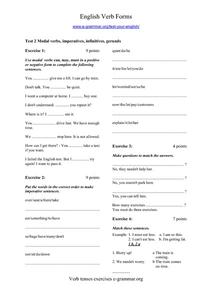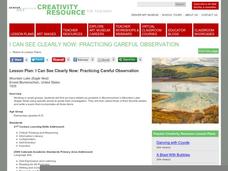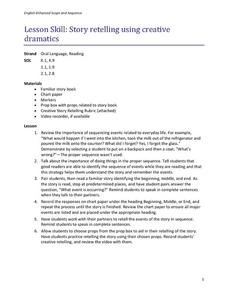Have Fun Teaching
Brick Breaker: Initial Consonant Blends
Practice initial consonant blends with a fun, interactive game! Choose the sounds you'd like to practice, and then have kids place the appropriate pictures for their brick breaker boards. Spin the spinner to select a blended sound, and...
University of Texas
Alphabetic Understanding, Phonics, and Spelling
Have your youngsters reading in no time with with collection of literacy activities and lessons. Starting with a basic understanding of the alphabet, this unit progressively builds students' phonemic awareness and ability to decode...
Texas Center for Learning Disabilities
Second-Grade Explicit Intervention
Unfortunately, not all students learn to read at the same pace, but with the help of this resource, you can ensure that they all receive the support they need to reach this important goal. Comprised of short...
Curriculum Corner
Fill in the Missing Letters
Scholars show what they know about the alphabet with a fill-in-the-blank activity that's missing some of its letters.
Curriculum Corner
Beginning Letter Mats
Sixteen colorful images make up a phonics worksheet focusing on initial sounds. Scholars name engaging images and identify what letter the word begins with.
Houghton Mifflin Harcourt
We Can Do It!: Extra Support Lessons (Theme 10)
Scholars participate in chants, grand discussions, and complete practice pages in a We Can Do It! themed unit. Designed to provide extra support, the assortment of lessons cover topics such as r-controlled vowels, comparatives...
K12 Reader
Find What the Adjective Describes
Adjectives can appear anywhere in a sentence, so spotting the nouns they describe can be tricky. Practice identifying parts of speech with a quick review worksheet in which learners circle the nouns in eight sentences that each adjective...
Curated OER
Lesson: Beyond First Impressions
Just like the colors and techniques used to create a vivid image, learners will use exceptional language to create vivid stories. They examine the techniques used to tell a visual story in the painting, Road to Santa Fe. They then use...
Curated OER
Lesson: Possible Perspectives
Visual art is the inspiration for a creative writing activity focused on having learners write from different perspectives. They analyze the image Yellow Rain Jacket, picking out details to help their storytelling. They use the details...
Twisty Noodle
Animal Action Cards Book
Can you stomp like a elephant? Or slither like a snake? Use these animal cards to get your little monkeys moving! Each card features an illustration and action word that matches the animal.
School District No. 71
Adding Written Detail: Using Jane Yolen’s Owl Moon as a Mentor Text
Access your senses with a worksheet on sensory language. Based on Owl Moon by Jane Yolen, the worksheet prompts kids to find examples of each of the five senses, as well as phrases for inner emotion.
Curated OER
Sea-ing More Clearly
Explore works of art with your class by engaging them in a variety of artistic activities including papier-mache sculpture, poetry, performance, and more. After viewing and discussing four paintings of the sea by Robert Harris, learners...
Curated OER
Lesson: Painting Stories
You're never too young for a instructional activity in fine art. Explore the painting Deucalion and Pyrrha, based on the Greek myth of the same name, with your class. You'll look at color, composition, texture, and technique, which are...
Curated OER
English Verb Forms
Challenge young grammarians with a short assessment on verbals. As your class progresses through each exercise, they demonstrate understanding for modal verbs, imperatives, infinitives, and gerunds.
Curated OER
Lesson: I Can See Clearly Now Practicing Careful Observation
Poetry and art analysis go hand-in-hand. In groups, youngsters analyze a landscape painting, making careful observations. They use details found in the painting to inspire an original poem. The poem must include at least three objects...
Curated OER
Arbitrary Arrangements: Daniel Sprick's Release Your Plans
Students investigate abstract artists as storytellers. For this art analysis lesson, students observe the small details in the painting called "Release Your Plans" by Daniel Sprick. Students collaborate in groups to create...
We are Teachers
The Six Traits in Plain Language
If your rockin' writers use Six-Trait Writing, you'll definitely want to include these displays around your classroom throughout the year. Each trait (e.g. voice, word choice, organization, ideas, sentence fluency, conventions) is...
American Sign Language University
ASL Interactive
Go over the building blocks of American Sign Language with an interactive alphabet tool. As learners of all ages hover their cursors over a letter, the image of a hand changes to reflect that letter's sign in ASL.
Curated OER
Comparing and Contrasting Heroes
Here is a language arts lesson that can be used with virtually any grade level. The only thing that changes is the reading level of the books. Learners compare and contrast different heroes and the characteristics they hold. They use a...
Curated OER
Story Retelling Using Creative Dramatics
Doing things in the proper sequence is the focus of a solid language arts lesson. In it, pupils discuss the importance of doing things in the right order. Then, they pair off and read a short story together. They must retell the story to...
Curated OER
Let's Learn Library Language
This PowerPoint presentation provides a review of 'library language', vocabulary associated with books and the library such as cover, title, author, illustrator, call number and fiction/nonfiction. Each slide of this PowerPoint displays...
Curated OER
Carnival of the Animals and Aquarium and Magic Fish
Engage little learners in this moderately developed three-lesson unit on the composer Camille Saint-Saens and his piece "The Carnival of Animals." Each lesson includes a listening, discussion, and an art project to engage your class in...
Curated OER
Online —On Stage—and Action
Use your tablets to participate in a culture-sharing project with a class in a foreign country. Your class can communicate and share ideas with a class in another country, swapping information regarding language and culture. Together you...
K12 Reader
Why Do We Need Pronouns?
Who needs pronouns? Everyone! Show your class the power of pronouns with this worksheet. Learners read a sample paragraph that doesn't include any pronouns and then revise that paragraph by filling in the appropriate pronouns.
Other popular searches
- English Language Arts Exam
- English Language Arts Games
- Deaf English Language Arts
- English Language Arts Music
- English Language Arts Heroes
- English Language Arts Skills
- Language Arts English
- English Language Arts Grade 3
- English Language Arts Poetry
- English Language Arts Rating=3
- English Language Arts Unit Sc
- Language Arts or English

























